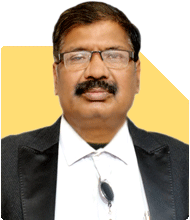49-Year-Old Man With Family Seeks Retirement Advice
Ramalingam Kalirajan |8086 Answers |Ask -Follow
Mutual Funds, Financial Planning Expert - Answered on Jul 15, 2024
He has an MBA in finance from the University of Madras and is a certified financial planner.
He is the director and chief financial planner at Holistic Investment, a Chennai-based firm that offers financial planning and wealth management advice.... more

I am 49 yrs male having 3 children & wife. My monthly income is 80 k. Invested 23 lacs in ppf Rs 5 lakh in NPS Rs. 10 lakh in mutual fund and 2 lakh in stock market. Kindly advise for retirement at 60 Yrs
Evaluating Your Current Investments
Public Provident Fund (PPF)
You have Rs. 23 lakh invested in PPF. This is a stable and secure investment. It offers tax benefits and a decent rate of return. However, the returns are not very high. Given your age, you should continue to invest in PPF but also explore other options for higher returns.
National Pension System (NPS)
With Rs. 5 lakh in NPS, you are on the right track. NPS is beneficial for retirement due to its tax-saving potential and long-term growth. The returns vary as NPS invests in a mix of equities and debt.
Mutual Funds
Your Rs. 10 lakh in mutual funds is commendable. Mutual funds offer good returns if managed well. It's crucial to regularly review the performance of these funds. Make sure they align with your risk appetite and retirement goals. Actively managed funds can outperform the market, especially in the long term.
Stock Market
Investing Rs. 2 lakh in the stock market shows your willingness to take risks for higher returns. Stocks can offer significant growth, but they also come with higher volatility. It’s essential to diversify and invest in companies with strong fundamentals.
Financial Goals and Risk Assessment
Retirement Planning
You aim to retire at 60, giving you 11 more years to build your retirement corpus. Your monthly income of Rs. 80,000 should allow for systematic investments. Given your current investments and age, you need a balanced approach to grow your wealth while managing risks.
Risk Tolerance
At 49, it’s crucial to balance between aggressive and conservative investments. While stocks and mutual funds offer growth, PPF and NPS provide stability. Diversification is key. Avoid putting all your eggs in one basket.
Enhancing Your Retirement Portfolio
Increase Mutual Fund Investments
Mutual funds should play a significant role in your retirement portfolio. They offer professional management and diversification. Actively managed funds can adapt to market changes, aiming for better returns.
Benefits of Actively Managed Funds:
Professional Management: Fund managers actively select stocks and bonds, aiming to outperform benchmarks.
Flexibility: They can shift investments based on market conditions, potentially offering better returns.
Diverse Investment Options: Various funds cater to different risk appetites and goals.
Disadvantages of Index Funds:
Limited Flexibility: They follow a fixed index, missing opportunities to outperform.
Potential Underperformance: In volatile markets, they might not adapt well, leading to lower returns.
Regular Funds vs. Direct Funds
Disadvantages of Direct Funds:
No Professional Guidance: You miss the expertise of a Certified Financial Planner (CFP).
Higher Risk of Poor Choices: Without professional advice, you might select underperforming funds.
Benefits of Regular Funds:
Expert Guidance: A CFP helps choose and manage funds, aligning them with your goals.
Better Diversification: Professional advice ensures a balanced portfolio, reducing risks.
Reassess Stock Market Investments
While your Rs. 2 lakh in stocks can grow, it’s vital to reassess. Focus on companies with strong fundamentals and growth potential. Avoid speculative stocks. Diversification within stocks is crucial to manage risk.
Strategic Steps Towards Retirement
Regular Investment Reviews
Schedule regular reviews of your investments. Markets change, and so should your strategy. A Certified Financial Planner can help you stay on track and adjust as needed.
Increase Contributions to NPS
NPS is beneficial for long-term growth and tax savings. Increasing your contributions can enhance your retirement corpus. Ensure you choose the right mix of equities and debt based on your risk tolerance.
Diversify Across Asset Classes
Diversification is crucial. Don’t rely solely on one type of investment. A mix of PPF, NPS, mutual funds, and stocks balances risk and return.
Consider SIP in Mutual Funds
Systematic Investment Plans (SIPs) in mutual funds allow for disciplined investing. They mitigate market volatility by spreading investments over time. SIPs are ideal for long-term wealth accumulation.
Planning for Children's Future
Your children’s future is important. Ensure you have enough funds for their education and other needs. Consider investing in child-specific plans or dedicated mutual funds for their future expenses.
Insurance Coverage
Ensure you have adequate life and health insurance. Protecting your family from unforeseen events is crucial. Evaluate your insurance policies regularly and update them as needed.
Emergency Fund
Maintain an emergency fund covering at least six months’ expenses. This fund should be easily accessible and kept in a liquid form. It provides a safety net during unexpected situations.
Tax Efficiency
Tax Planning
Effective tax planning enhances your savings. Utilize tax-saving instruments like NPS, PPF, and ELSS mutual funds. A CFP can guide you in maximizing tax benefits.
Rebalance Portfolio for Tax Efficiency
Regularly rebalance your portfolio to maintain the desired asset allocation. This also helps in tax efficiency. Sell investments strategically to minimize tax liabilities.
Monitoring and Adjustments
Regular Reviews with a CFP
A Certified Financial Planner can help you stay on course. Schedule regular meetings to review and adjust your strategy. Their expertise ensures your investments align with your retirement goals.
Adapting to Life Changes
Life is dynamic. Your financial plan should adapt to changes like job shifts, market conditions, and personal milestones. Be flexible and make necessary adjustments to your plan.
Final Insights
Your proactive approach to retirement planning is commendable. By diversifying investments and seeking professional advice, you can build a robust retirement corpus. Focus on a balanced strategy, regular reviews, and adapting to changes. These steps will ensure a secure and comfortable retirement.
Best Regards,
K. Ramalingam, MBA, CFP,
Chief Financial Planner,
www.holisticinvestment.in
You may like to see similar questions and answers below
Ramalingam Kalirajan |8086 Answers |Ask -Follow
Mutual Funds, Financial Planning Expert - Answered on Jun 04, 2024
Ramalingam Kalirajan |8086 Answers |Ask -Follow
Mutual Funds, Financial Planning Expert - Answered on Jul 06, 2024
Ramalingam Kalirajan |8086 Answers |Ask -Follow
Mutual Funds, Financial Planning Expert - Answered on Jul 15, 2024
Ramalingam Kalirajan |8086 Answers |Ask -Follow
Mutual Funds, Financial Planning Expert - Answered on Jul 15, 2024
Shalini Singh |148 Answers |Ask -Follow
Dating Coach - Answered on Mar 09, 2025
Rajesh Kumar Singh |170 Answers |Ask -Follow
IIT-JEE, GATE Expert - Answered on Mar 09, 2025
Radheshyam Zanwar |1384 Answers |Ask -Follow
MHT-CET, IIT-JEE, NEET-UG Expert - Answered on Mar 09, 2025
Radheshyam Zanwar |1384 Answers |Ask -Follow
MHT-CET, IIT-JEE, NEET-UG Expert - Answered on Mar 09, 2025
Radheshyam Zanwar |1384 Answers |Ask -Follow
MHT-CET, IIT-JEE, NEET-UG Expert - Answered on Mar 09, 2025
Radheshyam Zanwar |1384 Answers |Ask -Follow
MHT-CET, IIT-JEE, NEET-UG Expert - Answered on Mar 09, 2025
Radheshyam Zanwar |1384 Answers |Ask -Follow
MHT-CET, IIT-JEE, NEET-UG Expert - Answered on Mar 09, 2025
Radheshyam Zanwar |1384 Answers |Ask -Follow
MHT-CET, IIT-JEE, NEET-UG Expert - Answered on Mar 09, 2025
Radheshyam Zanwar |1384 Answers |Ask -Follow
MHT-CET, IIT-JEE, NEET-UG Expert - Answered on Mar 09, 2025
Mayank Chandel |2093 Answers |Ask -Follow
IIT-JEE, NEET-UG, SAT, CLAT, CA, CS Exam Expert - Answered on Mar 09, 2025



















